

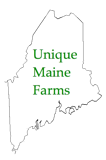

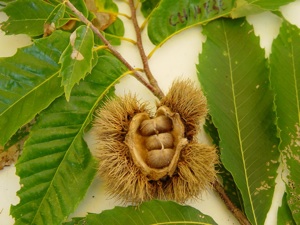
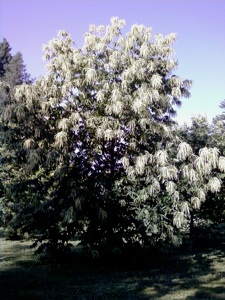
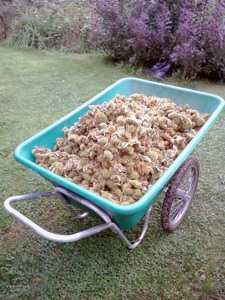
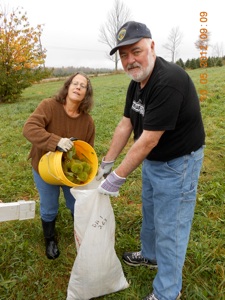
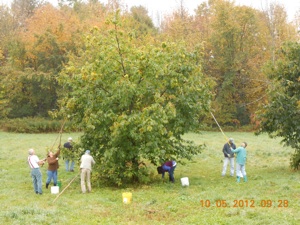
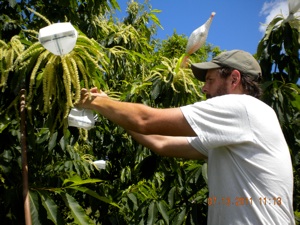
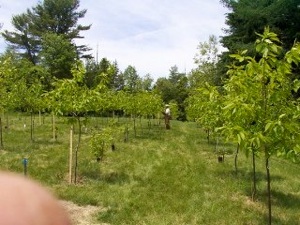
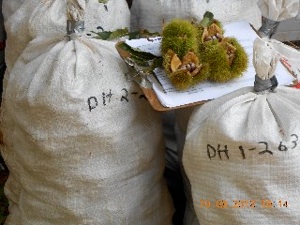
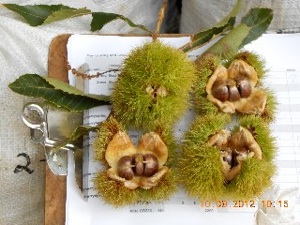
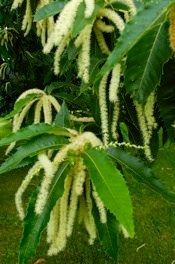

Name: Maine Chapter of the
American Chestnut
Foundation
President: Glen Rea
231 Buck Street
Bangor, Maine 04401
207-945-6945
Vice-President,
Breeding Coordinator: Eric Evans
207-235-9635
207-706-6913
Maine Chapter Website: www.me-acf.org
National ACF Website: www.acf.org
Orchard Locations:
Basin Preserve seed orchard - Phippsburg
Highmoor breeding orchard - Monmouth
Huff Hill seed orchard - Hartland
Merryspring breeding orchard - Camden
Mosher breeding orchard - Hope
Rowe breeding orchard - Hope
Dutton breeding orchard - Morrill
Granger breeding orchard - South China
Reed breeding orchard - Unity
PCCA seed orchard - Stetson
Bradley breeding orchard
Veazie Breeding Orchard
Products and Services:
-volunteer efforts to re-introduce American
Chestnut tree
-educational and research programs
-collaboration with American Chestnut
Foundation
-maintenance of seed and breeding orchards
What Makes The Maine Chapter of the American Chestnut Foundation Unique?
Up until the early part of the twentieth century, the American chestnut tree was an abundant and stately member of the forests. There was a time when one could enter the wooded areas from Maine to Georgia and extending westward to the Ohio Valley, and realize that on an average, one of four trees in the forest would be a chestnut.
The chestnut tree was prized for its straight formation, rapid growth, and rot-resistant wood. Its impressive height, sometimes reaching one hundred feet, proved to be valued. It was highly regarded as a source of quality timber and it proved to be a fitting kindling choice for starting fires to heat homes. Many farmers viewed chestnuts as a rich protein source to feed their livestock such as hogs and chickens. The high-tannin bark from the chestnut tree was used in the leather tanning process.
When chestnut trees flourished, the chestnuts were collected in large quantities and transported to urban areas where they were sold in stores. The culinary uses of chestnuts included being added to soups, stuffing, breads, and side dishes. Street vendors could often be spotted on street corners where they would be roasting and selling chestnuts.
The introduction of the Asian Chestnut Blight fungus in 1904, in New York City from Japanese nursery stock caused a major upheaval in the chestnut world. Because native chestnuts had very little resistance to the fungus that had been introduced from Asia, massive numbers of trees died. By the 1930’s, the chestnut tree in the east was considered to be functionally extinct. The fungus causes girdling cankers which cut off the water supply to the tree. Spores from the fungus were transported to other trees by the wind and birds.
By 1950, the loss of chestnut trees was estimated to be approximately four billion trees. The chestnut blight is the largest ecological disaster of the twentieth century. Besides being a tree with several qualities that were prized by humans, a variety of wildlife including squirrels, chipmunks, rabbits, voles, mice, and chipmunks depended on the seeds to supplement their diets. Black bear, deer, and wild turkeys also enjoyed feasting on the chestnuts.
Concerned individuals wishing to restore the chestnut tree established the American Chestnut Foundation in 1983. Several early restoration attempts proved unsuccessful. Scientists learned that a program to replace the American chestnut tree with Chinese chestnut trees did not work because of their shorter height and inability of Chinese chestnut trees to compete with other trees. Early breeding attempts failed. The breeding work of Arthur Graves and Charles Burnham proved to be instrumental.
American and Chinese chestnut trees are now being crossed and back-crossed to combat the blight by introducing blight-resistant genes from Chinese chestnuts into the remaining populations of American chestnuts. After thirty years of research, a high level of blight resistance is being attained and the specific characteristics of the American chestnut and its ability to compete in the forests is on the rebound.
A group of dedicated volunteers from Maine formed the fifth chapter of the American Chestnut Foundation in 1998. They help to maintain over fifteen chestnut breeding and seed orchards in Maine. Kendra Gurney, the New England Regional Science Coordinator of the American Chestnut Foundation, discussed how she was “forever amazed with the amount of work that is accomplished by the small corps
group of volunteers from Maine.” She elaborated that they don’t have a flashy annual meeting or an elaborate website, but they produce phenomenal results and truly know how to mobilize. She thought that the Maine Chapter collected around 20,000 nuts from the breeding orchards and 6,000-8,000 nuts to be planted in the seed orchards during 2012.
The Maine Chapter of the American Chestnut
Foundation focuses on breeding, research, and
educational projects. They are in search of volunteers to help with working at events such as fairs and garden shows; conducting library research; helping with mailings; telephoning; giving formal presentations; writing for the newsletter; fundraising; maintaining the Chapter website; and providing secure storage for equipment and supplies near an orchard. They also appreciate individuals who agree to step forward to plant seeds and seedlings in the spring; test for blight in the orchards in the summer; and collect seeds in October.
The Tree Urchin is the newsletter of the Maine Chapter of the American Chestnut Foundation.
It contains photographs of recent happenings in the state and information such as developments in the various orchards. The Autumn 2012 edition of The Tree Urchin contained updates about breeding and research accomplishments, coming events, chestnut recipes, volunteer opportunities, the President’s Report, and a timeline for the production of blight-resistant American-type Restoration Chestnuts.
Individuals who join The American Chestnut Foundation receive subscriptions to The Journal of the American Chestnut Foundation which is published six times a year, and membership in the Maine Chapter. Other membership benefits include discounts on Maine-native American chestnut seeds and seedlings. Blight-resistant seeds and seedlings from the research farms in Meadowview, Virginia, are now available to members and donors through the website of The American Chestnut Foundation: www.acf.org
The timeline of The Maine Chapter of The American Chestnut Foundation suggests that the Maine breeding program will start producing blight-resistant American-type chestnuts in about 2020.
The Maine Chapter of The American Chestnut Foundation is composed of a group of dedicated volunteers. While some may initially wonder why they have been included in a Maine farm project, it becomes quickly apparent after learning about their work in Maine that these volunteers are most definitely “genuine farmers.” They have focused their efforts on the reintroduction of a hardwood tree that is a vital part of the agricultural, historical, and commercial make-up of a good part of the eastern section of our country.





Mature generation #4 tree in full bloom in July 2012.
Harvesting chestnut burs October 2012.
Burs of the American Chestnut are shown on one of the trees located at the Merryspring Orchard.
Aaron Grimm is shown hand-pollinating a Maine-native chestnut tree at the Viles Arboretum to produce generation #4 of the breeding program. The American Chestnut tree can not self-pollinate.
Marharet Raurenhorst and Steven Teed are shown collecting chestnut burs.

Male catkins of the chestnut tree.


A special thank you is extended to Eric Evans for providing a great deal of information and several photos for this profile.
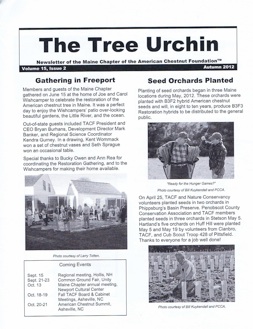
The Tree Urchin is the newsletter of the Maine Chapter of The American Chestnut Foundation.

